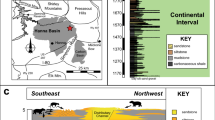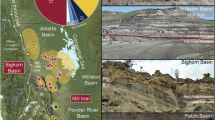Abstract
Several localities in northeastern Montana, USA, representing the earliest known Palaeocene mammal sites in the world, document a gradual turnover in the mammalian fauna at the Cretaceous–Tertiary boundary. These localities, in combination with previously known latest Cretaceous localities, represent the only well documented terrestrial sequence across the Cretaceous–Tertiary boundary. This sequence argues for gradual terrestrial extinctions and faunal changes at this boundary.
This is a preview of subscription content, access via your institution
Access options
Subscribe to this journal
Receive 51 print issues and online access
$199.00 per year
only $3.90 per issue
Buy this article
- Purchase on SpringerLink
- Instant access to full article PDF
Prices may be subject to local taxes which are calculated during checkout
Similar content being viewed by others
References
Clemens, W. A. Univ. Calif. Publs geol. Sci. 48, 1–105 (1964); 62, 1–122 (1966); 94, 1–102 (1973).
Lillegraven, J. A. Paleont. Contr. Univ. Kans. 50 (Vert. 12), 1–122 (1969).
Archibald, J. D. Univ. Calif. Publs geol. Sci. (in the press).
Clemens, W. A. & Archibald, J. D. Mém. Soc. géol. Fr. 139, 67–74 (1980); Archibald, J. D. & Clemens, W. A. in The New Uniformitarianism: Events on a Geologic Scale (eds Berggren, W. A. & Van. Couvering, J.) (Princeton Press, in the press).
Sloan, R. E. & Van Valen, L. Science 148, 220–227 (1965); Van Valen, L. & Sloan, R. E. 150, 743–745 (1965).
Van Valen, L. & Sloan, R. E. Evolut. Theory 2, 37–64 (1977).
Clemens, W. A. Science 184, 903–905 (1974).
Kielan-Jaworowska, Z. & Sloan, R. E. Acta palaeont. pol. 25, 187–197 (1979).
Van Valen, L. Evolut. Theory 4, 45–80 (1978).
Hickey, L. in The New Uniformitarianism: Events on a Geologic Scale (eds Berggren, W. A. & Van Couvering, J.) (Princeton Press, in the press).
Lerbekmo, J. F., Evans, M. E. & Baadsgaard, H. Nature 279, 26–30 (1979).
Leffingwell, H. A. Geol. Soc. Am. Spec. Pap. 127, 1–64 (1970).
Bakker, R. T. in Patterns of Evolution, as Illustrated by the Fossil Record Vol. 5 (ed. Hallam, A.) 439–468 (Elsevier, Amsterdam, 1977).
Alvarez, L. W., Alvarez, W., Asaro, F. & Michel, H. V. Science 208, 1095–1108 (1980).
Smit, J. & Hertogen, J. Nature 285, 198–200 (1980).
Hsü, K. J. Nature 285, 201–203 (1980).
Author information
Authors and Affiliations
Rights and permissions
About this article
Cite this article
Archibald, J. The earliest known Palaeocene mammal fauna and its implications for the Cretaceous–Tertiary transition. Nature 291, 650–652 (1981). https://doi.org/10.1038/291650a0
Received:
Accepted:
Issue date:
DOI: https://doi.org/10.1038/291650a0
This article is cited by
-
Late Cretaceous and paroxysmal Cretaceous/Tertiary extinctions
Nature (1987)
-
Der neue Katastrophismus: Fakten und Interpretation
Naturwissenschaften (1985)
-
Macroevolution: Large-scale replacements in the history of life
Nature (1983)
-
Evidence suggesting gradual extinction of latest cretaceous Dinosaurs
Naturwissenschaften (1983)



